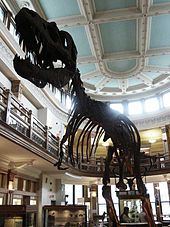Redpath Museum
The Redpath Museum is located in the Canadian Montreal and has its focus in the field of natural history . It is part of McGill University and is to the northwest of the campus, 859 Rue Sherbrooke Ouest.
In North America, natural history - preserving and making known the history and diversity of the natural world, as the museum itself describes its mandate - in addition to biological , palaeontological and mineralogical exhibition areas, often also includes ethnological topics that are often not traditionally assigned to history.
The building is the oldest museum in Canada and was opened in 1882. It goes back to a design by AC Hutchison and AD Steele. The architectural style mixes Victorian and Classical Greek elements.
Originally set up for university needs, the museum was opened to the public in 1952. Under the pressure of costs, the museum was forced to close its doors again from 1971 to 1985/1986. It has nearly three million exhibits.
management
The museum emerged in 1880 and 1882 from a donation from the sugar baron Peter Redpath . The first director was Sir William Dawson from Pictou (1820-1899). He was followed by Frank Dawson Adams from Montreal from 1892 to 1932. Thomas H. Clark , 1932–1952 and Alice Johannsen, 1952–1970, held this position for a similar length of time . Johannsen came from Cuba and began working as a university secretary after completing her studies. She was a co-founder of the Mont St. Hilaire Nature Conservation Center (1972). John B. Lewis, 1970–1985 and Robert Carroll, 1985–1991 and Graham Bell, 1995–2005, who were geologists or zoologists, was followed by David Green. He mainly deals with threatened species. He also served as chairman of the Committee on the Status of Endangered Wildlife in Canada (Committee for Endangered Species in Canada, 1998-2002) and as a scientific advisor in the Science Advisory Council of Fisheries and Oceans Canada (2002-2005), for the council for Fisheries and the oceans.
Exhibition levels, focal points, publications, teaching
In addition to the entrance hall, in which exhibits are exhibited that deal with the migration of living beings from land to sea, there are two further levels in the house. On the so-called second floor there are two galleries, the Dawson Gallery and the Hodgson Gallery. The former was renewed in 2003 and presents pieces on the natural history of the province of Quebec, the latter a Moluscan collection, the Abe Levine Shell Collection .
On the third floor is the collection on world cultures, which is referred to here as ethnology (ethnlogy). In addition to Egyptian mummies, this includes ethnological exhibits from all continents except North America. Numerous other minerals and fossils can be found in a geological garden outside the museum.
The museum conducts a lively publication activity that deals with the natural sciences, but also with archeology and ethnology as well as its own research history. In addition, the house is still used for student training and also attracts visiting scholars.
The house is supported by associations of former students, the friends of the Redpath Museum and numerous sponsors.
Collections

mineralogy
These collections are mainly due to six donors, whose first names, or more precisely their initials, are used for designation. The 16,000 exhibits come from Dr. Donald Doell (hence D for Doell Collection), a doctor, from the engineer Walter Frederick Ferrier (F for Ferrier Collection) or Jeffrey de Fourestier (J for Jeffrey Collection), Charles Palache (C), a professor. There is also the Shirley Collection (SC) from Sir Hugh Graham's wife, Lord Atholstan, and the New System collection, labeled NS, for general collections from various sources. This includes most of the holdings from the collections of the Natural History Society of Montreal and those of Lord Strathcona, as well as other holdings.
Entomology
The so-called Lyman entomology collections came to the Macdonald Campus in Sainte-Anne-de-Bellevue in 1961 . There the Lyman Entomological Museum and Research Laboratory was established .
paleontology
The fossil collection can also be traced back to a donor, Sir William Dawson , who contributed numerous plant fossils from Nova Scotia , as well as other items.
Ethnology and archeology
The ethnographic and archaeological collection is one of the oldest in North America and dates back to John William Dawson's collection. There were also exhibits from the Natural History Society of Montreal . The focus of the 17,000-piece collection is on Africa , ancient Egypt , Oceania , Europe and South America.
The exhibits of the Canadian First Nations are outsourced and form a focus of the McCord Museum in Montreal.
Sugar Museum
The museum also has a house in Toronto , the Redpath Sugar Museum, which opened in 1979 in the Redpath Sugar Building , which has been in existence since 1958.
Web links
- Redpath Museum website
- Redpath Museum, on biodiversity
- Lyman Entomological Museum and Research Laboratory
Remarks
- ^ About the Museum , McGill University.
- ^ Publications of the Redpath Museum
Coordinates: 45 ° 30 ′ 16 " N , 73 ° 34 ′ 39.2" W.


